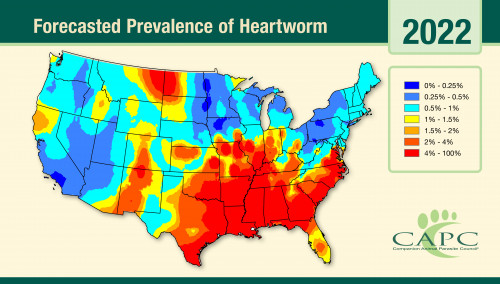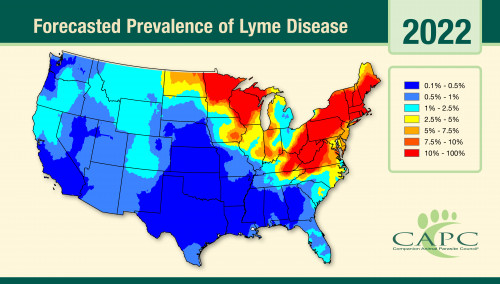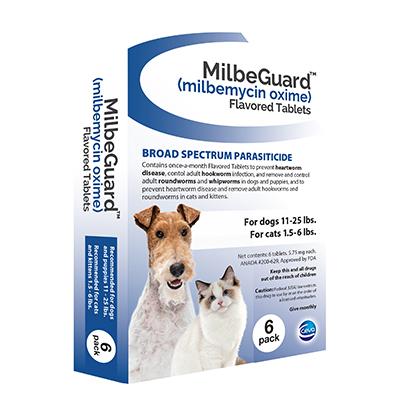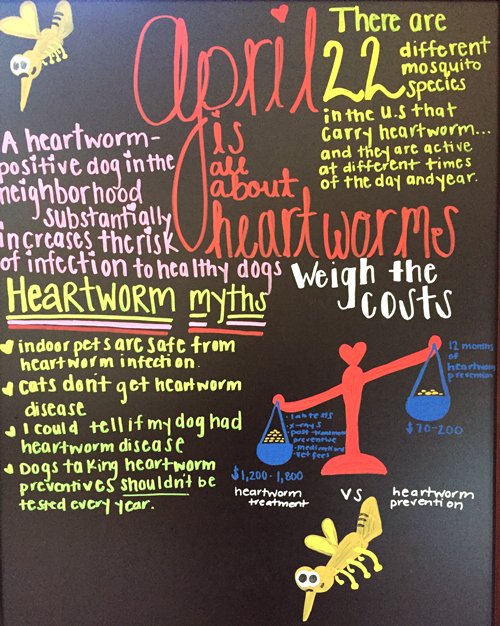What Are Heartworms?
April 23, 2024

Get the Facts on this Parasitic Worm
As the weather warms up, we’ve already experienced a few mosquito bites this year. These 10 facts about heartworms and the devastating disease they cause in pets are more important to know than ever.
- Heartworms are parasitic worms that live inside the heart, pulmonary arteries and/or lungs of an infected mammal
- Adult worms reproduce in the host animal and multiply in the bloodstream
- Dogs, cats, ferrets, wolves, coyotes and foxes can all contract heartworm disease
- One thing that makes them different from other parasitic worms? Most others infect the gastrointestinal tract, not the circulatory system
- Heartworms can grow to 14 inches in length
- Mosquitoes carry and spread heartworm larvae. When a mosquito bites a heartworm-infected animal (often wildlife), the larvae enters the mosquito along with the blood meal
- When a heartworm-carrying mosquito bites another animal (often a pet), the larvae spreads to that animal
- It takes months for heartworm disease to become visibly symptomatic in a pet. This is the time it takes for heartworm larvae to grow into adult worms
- Treatment in dogs is expensive, time-consuming and high-risk for the dog. There is no approved treatment for cats.
- Heartworm prevention is the best method to address heartworm disease for dogs and cats. Year-round prevention can come in several forms, from a monthly tablet to a combined flea-tick-and-heartworm medication. Ask your veterinarian which method is best for your pet and lifestyle
For more information, check out our recent article, “Heartworm Prevention: Be Aware!” And contact us if your Fairfield or Cincinnati-area pet is in need of heartworm prevention and other wellness care.
Read More
Heartworm Prevention: Be Aware!
April 9, 2024

Save Your Pet from this Deadly Parasite
Heartworm disease is cause by a parasitic worm carried by mosquitoes. Over 70 species of mosquito are capable of transmitting heartworm to dogs, cats and ferrets through their bites. And it only takes one bite to cause this life-threatening infection.
The worms are called Dirofilaria immitis and grow to a foot long. They live in an animal’s heart, lungs and blood vessels.
How Common is Heartworm?
Infected mosquitoes are found in all 50 US states. It’s estimated that one million dogs in the US are suffering from heartworm disease. And up to one-third of heartworm-infected cats live exclusively indoors.
Heartworm Prevention is Simple and Cost-Effective
Not only is prevention simple and cost-effective, it saves lives! The risk that one infected mosquito will bite your pet one time is quite high.
All pets should be on a heartworm prevention medication 12 months of the year (all year round!). And, to be on the safe side, we recommend annual heartworm testing.
Heartworm Disease is Heart-Breaking
Outcomes for heartworm disease aren’t pleasant. It takes six months after being bitten by an infected mosquito to test positive for the disease. The parasitic worms have opportunity to grow unchecked during that time.
There is only one approved treatment for dogs, and it can cost up to 15x’s the cost of a year’s worth of prevention medication. Plus, it’s high-risk for your dog, with the potential side effect of a fatal pulmonary embolism.
Even more alarming, there are NO approved treatments for cats with heartworm disease.
Check out our Heartworm Prevention Resources for more information, like Heartworm Myths and True Stories of Heartworm Disease. Ready for prevention? Contact us for an appointment.
Read More
April is National Heartworm Awareness Month
April 10, 2023
7 Fast Facts about Heartworm Disease

- Did you know dogs and cats get heartworms from mosquitos?
- Most dogs show few or no signs of heartworm infection in the early stages of the disease
- Mosquitos– the vectors for heartworm infection– live both outside and indoors
- Standing water increases mosquito populations
- All dogs should be tested annually for heartworm infection, even if they are taking monthly preventatives
- Dogs are the typical hosts for heartworms, but the parasite also infects cats, wolves, coyotes, foxes and other animals
- Although heartworm incidence varies by region of the country, cases of heartworm infections have been diagnosed in all 50 states
Heartworm Disease in Ohio
Last year, 3,043 dogs and 24 cats tested positive for heartworm disease in Ohio. In 2021, 3,381 dogs and 36 cats tested positive for heartworm disease in our state.
Heartworm is a constant threat to pets, and it’s not going away. That’s why heartworm preventatives are so important to protecting our cats and dogs. Here’s one last sad statistic:
“Virtually 100% of dogs exposed to infective heartworm larvae become infected; in cats, this number drops to 61% to 90%.”
If your pet isn’t currently taking heartworm preventative, contact us today to make an appointment with your veterinarian.
Read More
Heartworm Awareness Month: We Still Need to Talk About It
April 19, 2022
Heartworm Disease is Completely Preventable, So Let’s Prevent It
Each year, the Companion Animal Parasite Council (CAPC) provides a pet parasite forecast. In 2022, they expect the risk of heartworm infection to be somewhat elevated.

During 2021 in Ohio, here’s how many positive heartworm cases were reported:
Already this year, there have been 756 heartworm-positive dogs and 5 cats reported.
Each year, to help more pets receive care, we address heartworm facts. Here’s a roundup of our heartworm prevention articles.
Myths About Heartworm Disease
Have you heard that indoor cats can’t get heartworms? Myth! That heartworms are only transmitted in the summer? Myth!
More Myths Debunked…
True Stories of Heartworm Disease
Watch the story of two dogs who contracted heartworm disease. One dog gets a happy ending, but one is an all-too-true tale of tragedy.
Watch the Video…
What is Heartworm Disease Like in Dogs and Cats?
In a word: heartbreaking. And entirely preventable.
Learn What’s It Like…
The Cost of Prevention vs. the Cost of Treatment
Prevention costs about $70 – $200 per year, while treatment costs over a thousand dollars. (And it might not be successful).
More About Costs…
Don’t Forget About Ticks
In other news, the CAPC also predicts 2022 will be a particularly bad year in our region for ticks and Lyme disease. Comprehensive flea and tick preventative can help keep your pet from bringing an infected tick into your home. And, be safe out in the woods!

Questions about heartworm prevention or your pet’s heartworm preventative? Contact us.
Read More
Heartworm is a Heartbreaking Disease that is Entirely Preventable
April 16, 2020
 Frequently asked questions about heartworm disease on Google include:
Frequently asked questions about heartworm disease on Google include:
- How long can a dog live with heartworms?
- Can indoor cats get heartworm?
- How long does it take for heartworm symptoms to show?
- Does heartworm treatment shorten a dog’s life?
- What are the final stages of heartworm?
These questions show the sadness, fear and anxiety that come from worrying if a cat or dog might have heartworm disease. It’s heartbreaking to think of these animals suffering.
 What Heartworm is Like in Cats
What Heartworm is Like in Cats
“Signs of heartworm disease in cats can be very subtle or very dramatic. Symptoms may include coughing, asthma-like attacks, periodic vomiting, lack of appetite, or weight loss. Occasionally an affected cat may have difficulty walking, experience fainting or seizures, or suffer from fluid accumulation in the abdomen. Unfortunately, the first sign in some cases is sudden collapse of the cat, or sudden death.”
What Heartworm is Like in Dogs
“Signs of heartworm disease may include a mild persistent cough, reluctance to exercise, fatigue after moderate activity, decreased appetite, and weight loss. As heartworm disease progresses, pets may develop heart failure and the appearance of a swollen belly due to excess fluid in the abdomen. Dogs with large numbers of heartworms can develop a sudden blockages of blood flow within the heart leading to a life-threatening form of cardiovascular collapse. This is called caval syndrome, and is marked by a sudden onset of labored breathing, pale gums, and dark bloody or coffee-colored urine. Without prompt surgical removal of the heartworm blockage, few dogs survive.”
Heartworm Prevention is Easy and Worth It
Compared to the severity of heartworm disease, prevention is easy, inexpensive and very much worth doing. We prescribe heartworm preventative medications for all of our cat and dog patients. Give us a call with any questions or to setup an appointment.
Read More
April is Heartworm Awareness Month
April 15, 2019

Heartworm: What’s the Risk?
The risk of heartworm infection can be right next foor at any time. Heartworm season is year-round. And a heartworm-positive dog in the neighborhood substantially increases the risk of infection to healthy dogs.
 Mosquito Facts
Mosquito Facts
There are 22 different mosquito species in the US that carry heartworm. An average of 7 in 10 mosquitoes in a heartworm-positive dog’s kennel carry heartworm.
Heartworm Myths: True or False?
 Heartworms don’t live in my backyard: False! Although heartworm incidence varies by region in the country, cases of heartworm infection have been diagnosed in all 50 states.
Heartworms don’t live in my backyard: False! Although heartworm incidence varies by region in the country, cases of heartworm infection have been diagnosed in all 50 states.- Dogs taking heartworm preventatives should be tested every year: True! All dogs should get a heartworm test.
- Cats don’t get heartworm disease: False! Cats do get heartworm disease. The best strategy for cats is a 12-month preventative.
- Indoor pets are safe from heartworm infection: False! Mosquitoes, which are the vector for heartworm infection, live both outside and indoors.
- I could tell if my dog had heartworm disease: False! Most dogs show few or no signs of heartworm infection in the early stage.
- Only dogs and cats get heartworms: False! Dogs are the typical host for heartworms, but the parasite also infects wolves, coyotes, foxes and other animals.
If you have any questions about your pet’s health, please give us a call at (513) 829-8989.
Read More
Heartworm is More Contagious and Dangerous than You Might Think
April 19, 2018

April is Heartworm Awareness Month
 Nearly everyone with a dog knows about heartworm and the importance of preventing the parasitic disease. A simple medication given once a month prevents the danger of a heartworm-infected mosquito infecting your dog and starting the long, expensive and painful course of the disease, treatment and possible recovery.
Nearly everyone with a dog knows about heartworm and the importance of preventing the parasitic disease. A simple medication given once a month prevents the danger of a heartworm-infected mosquito infecting your dog and starting the long, expensive and painful course of the disease, treatment and possible recovery.
3 Facts to Know about the Spread of Heartworm Disease
Your dog may be at more risk than you think for heartworm disease. Here are three facts that show why heartworm is more dangerous and contagious than most people realize:
- Heartworm infection also transfers from an infected dog to the mosquitoes that bite it. An average of 7 in 10 mosquitoes in a heartworm-positive dog’s kennel carry the parasite.
- A heartworm-positive dog in the neighborhood substantially increases the risk of infection to healthy dogs.
- There are 22 different mosquito species in the U.S. that carry heartworm. They are active at different times of the day and different times of year. This makes heartworm “season” year-round.
Fortunately, Heartworm Prevention is Simple!
 By giving your pet a monthly preventative medication every month, you can ease your mind and know your pet is safe from heartworm disease. The annual cost of heartworm preventative is $70-$200, which is economical compared to the cost of treating heartworm (up to $1,800!).
By giving your pet a monthly preventative medication every month, you can ease your mind and know your pet is safe from heartworm disease. The annual cost of heartworm preventative is $70-$200, which is economical compared to the cost of treating heartworm (up to $1,800!).
We wish you and your pet a happy, healthy spring! If you have more questions about heartworm disease and prevention, give us a call or check out our article, “Heartworm Prevention: Weigh the Costs.”
Read More
April is All About Heartworm Prevention
April 13, 2017

Heartworm Prevention: Weigh the Costs
 Mosquito season has started in Southeastern Ohio. The American Heartworm Society offers a very good explanation of how these pesky insects can deliver a deadly disease to your dog or cat:
Mosquito season has started in Southeastern Ohio. The American Heartworm Society offers a very good explanation of how these pesky insects can deliver a deadly disease to your dog or cat:
“The mosquito plays an essential role in the heartworm life cycle. Adult female heartworms living in an infected dog, fox, coyote, or wolf produce microscopic baby worms called microfilaria that circulate in the bloodstream. When a mosquito bites and takes a blood meal from an infected animal, it picks up these baby worms, which develop and mature into “infective stage” larvae over a period of 10 to 14 days. Then, when the infected mosquito bites another dog, cat, or susceptible wild animal, the infective larvae are deposited onto the surface of the animal’s skin and enter the new host through the mosquito’s bite wound.”
$1,200 – $1,800: Cost of Heartworm Treatment
 Heartworm infections are expensive and can be dangerous to treat. If your dog or cat needs heartworm treatment, it will include:
Heartworm infections are expensive and can be dangerous to treat. If your dog or cat needs heartworm treatment, it will include:
- Lab tests
- X-Rays
- Medications
- Post-Treatment Preventative
- Vet Fees
$70 – $200: Cost of One Year of Heartworm Prevention
 On the other hand, heartworm prevention is fairly economical and simple. Just give your pet the preventative medication every month, and your cat or dog will be safe from this disease.
On the other hand, heartworm prevention is fairly economical and simple. Just give your pet the preventative medication every month, and your cat or dog will be safe from this disease.
Learn More About Heartworm Disease and Prevention
Watch this helpful animation video to learn more about the heartworm lifecycle and how infections affect animals.

Read More







 Frequently asked questions about heartworm disease on Google include:
Frequently asked questions about heartworm disease on Google include: What Heartworm is Like in Cats
What Heartworm is Like in Cats
 Mosquito Facts
Mosquito Facts Heartworms don’t live in my backyard:
Heartworms don’t live in my backyard: 
 Nearly everyone with a dog knows about heartworm and the importance of preventing the parasitic disease. A simple medication given once a month prevents the danger of a heartworm-infected mosquito infecting your dog and starting the long, expensive and painful course of the disease, treatment and possible recovery.
Nearly everyone with a dog knows about heartworm and the importance of preventing the parasitic disease. A simple medication given once a month prevents the danger of a heartworm-infected mosquito infecting your dog and starting the long, expensive and painful course of the disease, treatment and possible recovery. By giving your pet a monthly preventative medication every month, you can ease your mind and know your pet is safe from heartworm disease. The annual cost of heartworm preventative is $70-$200, which is economical compared to the cost of treating heartworm (up to $1,800!).
By giving your pet a monthly preventative medication every month, you can ease your mind and know your pet is safe from heartworm disease. The annual cost of heartworm preventative is $70-$200, which is economical compared to the cost of treating heartworm (up to $1,800!).
 Mosquito season has started in Southeastern Ohio. The
Mosquito season has started in Southeastern Ohio. The  Heartworm infections are expensive and can be dangerous to treat. If your dog or cat needs heartworm treatment, it will include:
Heartworm infections are expensive and can be dangerous to treat. If your dog or cat needs heartworm treatment, it will include: On the other hand, heartworm prevention is fairly economical and simple. Just give your pet the preventative medication every month, and your cat or dog will be safe from this disease.
On the other hand, heartworm prevention is fairly economical and simple. Just give your pet the preventative medication every month, and your cat or dog will be safe from this disease.